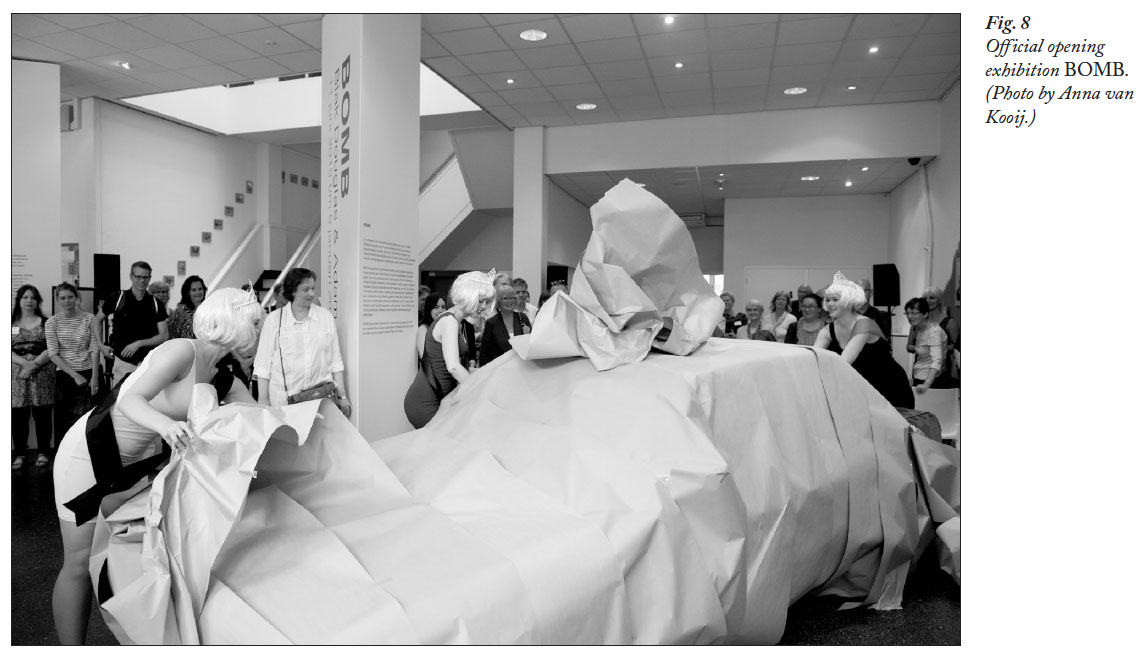Exhibition Review / Compte rendu d’exposition
Colonizing the Museum?
Contemporary Art, Heritage and Relational Museology
Contemporary Art and Heritage
1 The exhibition BOMB, at the Museum of Contemporary Aboriginal Art (AAMU), Utrecht, the Netherlands, is an artistic exploration of nationalism, racism and discrimination in Australia; it is also part of the cultural program celebrating the 300th anniversary of the Vrede van Utrecht (Treaty of Utrecht 2013). Drawing the War of Spanish Succession to a conclusion, the 1713 Treaty of Utrecht brought peace to the warring states of Europe, partly by refocusing aggression on other areas of the world. The Dutch were not seriously interested in colonizing Australia, despite having landed on the northeast coast in 1623. While Dutch East India Company merchants and mariners were the first recorded Europeans to set foot on the continent, their main interest was expansion of trade in Indonesia. Britain, which emerged as a world power as a result of the 1713 Treaty, went on to colonize Australia in 1788. This historical framework provides the starting point for BOMB. Part of Utrecht’s year-long commemoration of an event in its own history, the AAMU provided a staging ground for this critical exhibition. It reminds us of the historical reconfiguration of power relations that took place in this city 300 years ago, which had profound consequences elsewhere in the world.
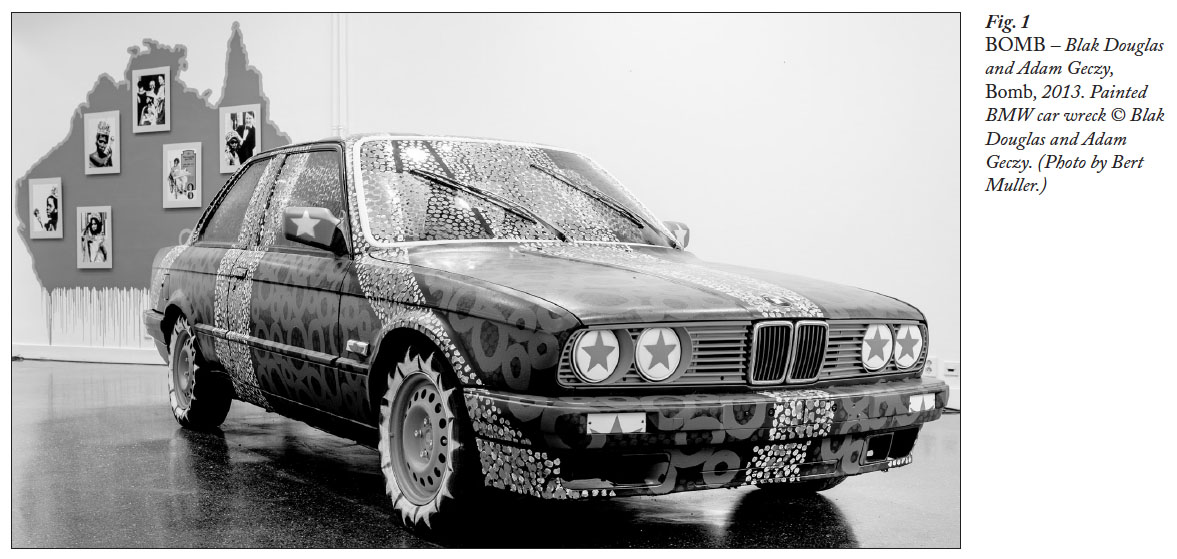 Display large image of Figure 1
Display large image of Figure 12 BOMB is a collaborative exhibition between the Sydney-based artists Blak Douglas (aka Adam Hill) and Adam Geczy, comprising some twenty pieces: a painted BMW car, eight video works, four wall paintings, five installations, a photograph and a silk screen print. These are installed on the ground and first floors of the AAMU.
3 This review considers some of the relational dimensions of the show. Bourriaud, in his work on relational aesthetics, refers to the exchanges that take place between people in gallery or museum space as becoming the raw material for an artistic work. He also refers to the way in which artists occupy the exhibition process (2002: 16,17). How did the Australian artists engage with the Utrecht museum—as an institution, a group of professionals and volunteers, a collection, a set of spaces, a place or a site? This question involves evaluating the artists’ claims to be “occupying” or even “colonizing” the museum in the context of Utrecht’s heritage dynamics. If diplomacy and peaceful negotiation associated with Utrecht in 1713 become resources in the 2013 celebrations, which were also intended to support Utrecht’s claim to become European Capital of Culture in 2018, how does critical appraisal of imperialism and colonization in Australia operate within this framework? What effect does Utrecht’s European location, combined with the heritage dynamics of commemoration—such as grafting contemporary art onto this historical frame—have on the artistic, social and political questions addressed in the exhibition? And how are forms, images, sounds, materials, colours and words chosen and interwoven with spaces inside and outside the AAMU? The analysis considers several exhibition strategies enlisted in the production of BOMB—ranging from research to site-specific work, bricolage and performances—by the artists themselves or by delegated performers.
4 Activist art, as Lieven de Cauter characterized the works in his address at the exhibition’s opening, appropriates and subverts dominant symbols, including what Laurajane Smith calls “authoritative heritage discourse” (2011: 11), undermining and exposing assumptions, and questioning national discourses. But which national discourses in which national context(s) are we talking about when dealing with critical Australian contemporary art in Utrecht? The artists’ careful selection, transformation and mixing of such symbols engages and implicates the exhibition’s sites and its audiences, who include both local visitors and Australian tourists surprised by their encounter with this critical show in the Netherlands.
5 How specific are heritage dynamics in Europe, whereby activist art such as BOMB finds a venue amid the Treaty of Utrecht celebrations? Let us briefly juxtapose BOMB in Utrecht with the National Gallery of Canada’s major contemporary art exhibition of 2013, Sakahàn: International Indigenous Art, in which the works of eighty artists from sixteen different countries were assembled in Ottawa to “provide diverse responses to what it means to be Indigenous today” (Sakahàn 2013). Both events have indigeneity as a major theme, and both enhanced the cultural profiles of their respective cities but in distinctive ways. The Treaty of Utrecht program took place in different parts of the city—in its eleven museums, in various neighbourhoods, in a shopping mall—and in nearby towns. Sakahàn’s over-arching focus on indigeneity created spaces for a “global conversation” among artists (including Australian artists Vernon Ah Kee, Richard Bell and Brenda Croft), with artworks ranging video installations to sculptures, drawings, prints, paintings, performance art, murals and other new, site-specific projects. The artists
6 Although many of the concerns of Sakahàn and BOMB seem similar, Blak Douglas and Adam Geczy were not part of a broader international convergence of contemporary artists examining these issues together in Utrecht. This perhaps made their position more circumscribed than that of the artists in Ottawa. And if the artists at the AAMU see themselves as “colonizing the museum,” it is important to consider how the institution facilitated that process. Despite the differences in scale, scope and focus, both exhibitions are actively engaged in heritage understood as a process of cultural production, where contemporary art is involved in re-defining heritage-making processes (Smith 2011: 9; see also Kirshenblatt-Gimblett 2006). Let us look briefly at the Utrecht exhibition setting in relation to Aboriginal art, culture and heritage in Australia.
Settings
7 The AAMU is a potent setting for Blak Douglas’s and Adam Geczy’s collaboration. Established by a private foundation in 1999, the museum opened in a former bank building on the Oude Gracht in Utrecht in 2001 (Petitjean 2008). The museum’s mandate is “to bring Dutch and foreign visitors into contact with Aboriginal art, and, additionally, to exhibit the various directions and trends that have developed during the short existence of this art form since 1971” (AAMU 2013). While there is a long tradition of Aboriginal art forms (body painting, sand painting, bark painting, rock art), the Western Desert Art Movement that began in Papunya Tula in the early 1970s marked a turning point, introducing Australian Aboriginal artists into the international contemporary art market. The second floor of the AAMU houses a permanent exhibition based on Australian regional art traditions (Arnhemland, Kimberley, Central Desert, Tiwi Islands, city-based), while temporary exhibitions are held on the ground and first floors twice each year.
8 The arrival of the British First Fleet settlers in 1788 marked Australia as terra nullius (land belonging to no one), solidifying a concept that has its origins in Cook’s voyages and, prior to that, Renaissance imaginings of the Terra Australis (one of the early names for Australia; McLean 1998). The appropriation of land that followed was consistent with the denial of any pre-existing indigenous art practices, a denial that was reinforced by 19th-century social evolutionary theory (Morphy 1998: 21); indigenous people were classified as hunter-gatherers who were close to nature, lacking title to land, religion and art, and hence without rights when measured against European standards. These assumptions, and their disastrous consequences, held sway until as recently as 1967, when people of Aboriginal descent were finally granted Australian citizenship. Aboriginal art, culture and heritage slowly gained recognition among dominant class fractions of Australian society. However, the deeper habits of racism and discrimination proved harder to eradicate. It is this darker side of Australian life that Blak Douglas and Adam Geczy investigate in their work. They engage a wide range of categories, materials and forms—Barbie dolls, BMWs, bullets, golf balls, T-shirts, flip flops, national flags, maps and anthems—transforming them into new configurations. How does contemporary art, such as this, fit into the developments in Australian art since the 1970s?
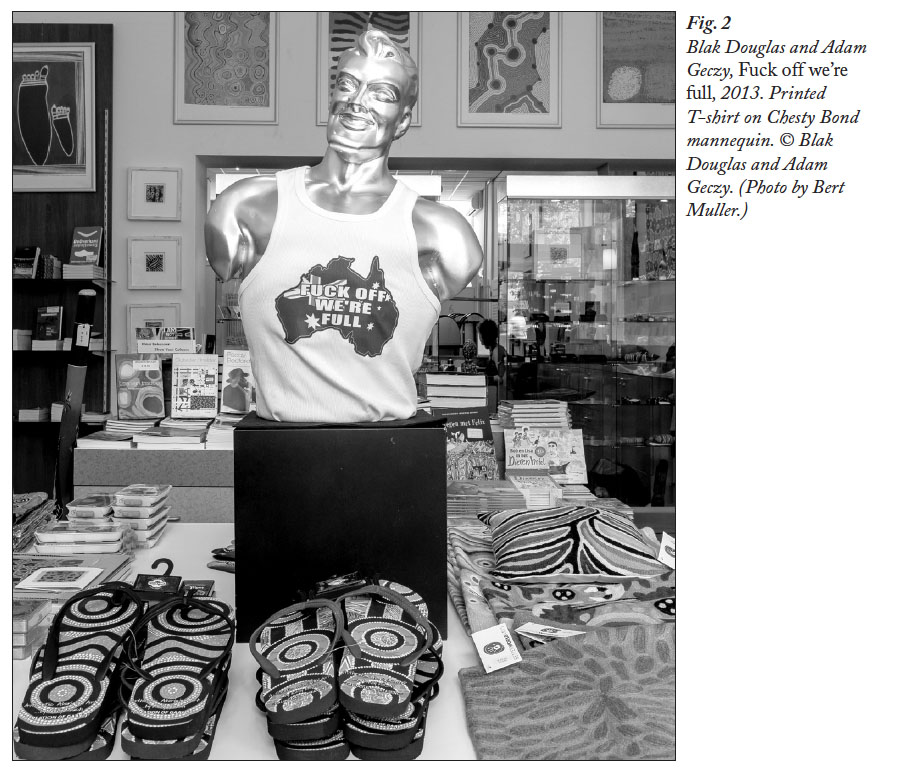 Display large image of Figure 2
Display large image of Figure 29 While the bark paintings of artists such as Mawalan Marika of Arnhem Land, and the Central Desert watercolours by Albert Namatjira, achieved national fame earlier in the 20th century, it was the Papunya Tula art movement that laid the foundations for a profound shift in the Australian art world (Myers 2002; McLean 2011). Former ceremonial, secret designs were transposed from the body, sand and sacred artifacts onto two-dimensional canvas boards, using acrylic paint. Certain figurative elements of the Dreamings—a dimension of time and space connecting ancestral beings to the present through art and ritual and by exercising rights in land and sacra (Morphy 1998: 145)—were later camouflaged through infilling with dots. These paintings attracted new audiences and significantly re-positioned Aboriginal culture and art within the ideological framework of the Australian nation state. The national recognition given to selected aspects of Aboriginal culture in the 1970s, and the international success of contemporary Aboriginal fine art in the 1980s, led to its gradual appropriation as an alternative source of national identity when the country celebrated its bicentennial in 1988. Aboriginal artists invited to participate in these celebrations in the spirit of reconciliation made use of the occasion, which situated the nation’s colonial origins at the landing of the First Fleet (Morphy 1998: 413), to problematize the predominantly celebratory tenor of the occasion. The Aboriginal Memorial, consisting of 200 hollow-log coffins painted by Ramininging artists from Central Arnhem Land, was one such counter-monument. In commemorating 200 years of racism, discrimination and genocide, a work at the very heart of a national celebration was subversive but also persuasive (see Morphy 1998: 413; McLean 2011: 42). First installed in Sydney harbour, close to where the First Fleet landed, the monument was a powerful evocation of ancestral presence—in terms of the human-scale size of the works, their decoration with clan designs, and the effects of constantly changing natural light—and an incisive reproach made with numerical precision to the re-enactment of the landing featured in the 1988 celebrations.
10 Writing for the exhibition catalogue, art historian Ian McLean contends that BOMB adopts a position similar to that of the Aboriginal Memorial in the Australian Bicentennial celebrations of 1988 (McLean 2013). He argues that the title piece, the painted BMW carcass, explodes the whole enterprise of art museums—including the AAMU—over the past twenty years. The commercial success of Aboriginal art was related to a market for modernist abstraction and emphasized by such institutions in their gallery aesthetics (see Myers 2002: 197). Blak Douglas and Adam Geczy confront us with the contradictions of a socio-economic system that elevates Aboriginal art while simultaneously preventing Aboriginal communities from advancing. This argumentation prompts many questions. How does the AAMU live out such contradictions? Have the artists indeed engineered a relational space? What role did the process and performance of installation play in the curatorial strategies of the show? What kinds of ambivalences arose and how are they managed by the institution? How can the AAMU produce this other history of Aboriginal art, in Dutch, for a Dutch audience, for whom the notion of Central and Western Desert “fine art” is already a challenge? To investigate these questions, let us take a closer look at four groups of works: Bomb, Barbie Koori, White Man Black Man and Silver Bullet.
Bomb: Bricolage, Fine Art, Capitalism, Copyright
11 The first work the visitor encounters is Bomb itself, as an artwork, a piece of bricolage and a powerful metaphor. The title piece of the exhibition can be glimpsed through the window from the street outside, as if the gallery were a car show room. The 1989 (downsized, two-door version of the) BMW M3 car painted with the Union Jack flag issues forth from a dripping red map of Australia painted on the wall behind it projecting a vortex of red, white and blue lines, dots, circles and stars. It is one of the pieces produced by the artists during the ten days before the opening, and is emblematic of their collaboration. The AAMU acquired the old BMW wreck and the artists worked on it, sometimes together, in full public view. The extensive exhibition text makes explicit reference to Warlpiri artist Michael Nelson Tjakamarra who was commissioned in 1989 to paint an art car for the BMW corporate art collection. Car wrecks are a source of repair material for contemporary nomads living in the central deserts of Australia, where Michael Nelson Tjakamarra is from, so that bricolage becomes a survival strategy. Cars are also used as a form of payment by rogue dealers in exchange for paintings and therefore refer to exploitative practices in the art world. Both the exhibition text and a scale model of Tjakamarra’s art car acknowledge these sources of Bomb while adding layers to them.
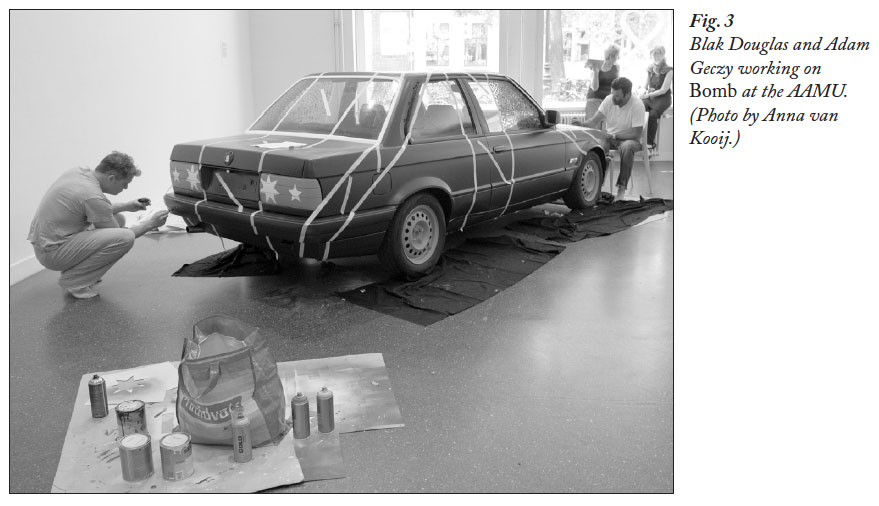 Display large image of Figure 3
Display large image of Figure 312 Tjakamarra’s car is a pointed reference for several reasons: his carefully painted Dreamings on the 1989 BMW leave the vehicle recognizable and its glass surfaces transparent. Blak Douglas and Adam Geczy have painted the Union Jack right over the outside surfaces of Bomb (windows included) onto a royal blue ground. The dotting used for the red and white stripes, combined with circles in lighter blue, completely covers the outside, camouflaging the upholstery which itself is painted with stars in the yellows, ochres, browns and blacks distinctive to Aboriginal art. This approach sets up a new alternation between the outside and the inside: the inside is identified as Aboriginal, and carefully obscured. Parts of the vehicle are thus deliberately hidden from full view, while other tiny details—windscreen wipers in gold, wheel hubs in red, nuts in gold, rims in spiky white, red stars on the headlights and backs of the wing mirrors—are elaborately improvised. The word “BOMB” replaces the BMW logo, and the number 225 on the boot specifies the number of years since colonization. The word “bomb” associated with a car conjures up separatist (IRA, ETA), and more recently insurgent (Iraq), car bombings. This car bomb, however, with its wing mirrors bearing white-painted texts on black (“Grandfather told me always look forward ... don’t look black”; “Beware: some people are more difficult to eradicate than they appear”) startles and intrigues. Passers-by who catch a glimpse of the transfigured vehicle are drawn inside, some seeing it as a photo opportunity.
13 While you inspect Bomb from all sides, the sound of Richard Green reciting a poem about the land that was taken away from his people echoes in your ears: “they say, we cheat, we lie....” The sound of this declamation is there all the time, while purchasing a ticket, viewing Bomb or inspecting the map of Australia. It can be heard in the museum gift shop, which is filled with Australian tourist art, and where the silver-painted Chesty Bond1 mannequin sports a T-shirt emblazoned with the words “Fuck Off We’re Full”—sentiments that grace Australian, anti-immigration hate websites and Facebook pages. The T-shirt cleverly parodies the tourist T-shirts that made illegal use of Aboriginal designs (see Fig. 2) and led to major copyright controversies in 1988 (Morphy 1998: 416). Embedding this work amid tourist art and merchandise, with Green’s persistent voice-over in the background, disrupts the “business as usual” calm of the museum shop.
Barbie Koori: Gender and Performance
14 Barbie Koori, as the dripping red map of Australia is called (see Fig. 1), is an installation piece that bears six black and white portraits of Aboriginal women whose faces replace those of the original beauty queens in past Australian beauty contests. By referring to a time when only women of British descent were deemed eligible for such competitions, the artists add gendered racial discrimination to the xenophobia that is ripe for appropriation. The beauty queen theme was elaborated in a performance piece that took place in Utrecht on June 13, when four white female students dressed as misses and handed out leaflets about the plight of Aboriginal women in the Town Hall square. The performers, liberal arts and sciences students recruited from University College Utrecht, prepared their roles by way of meetings with their performing arts teachers, the curator and the artists. Their performance was intended to make the public curious about the exhibition, by exploiting and undermining the Barbie doll stereotype. Public reactions were mostly indulgent, along the lines of, “Ooh, what lovely little princesses!” The performers experienced both the risqué dimension of standing in a public space, scantily and provocatively clad, handing out leaflets with a smile, and were themselves surprised to learn about the plight of Aboriginal women through the project. Barbie Koori connects with, yet differs from, the still photograph The Profligacy and the video work Refuse/ Refuse, located on the first floor. The Barbi Koori actresses declined to dress in bikinis, as The Profligacy model does, choosing instead slinky dresses, high-heels, blond wigs and tiaras to inhabit convincing roles that had seemed quite two-dimensional in concept form.
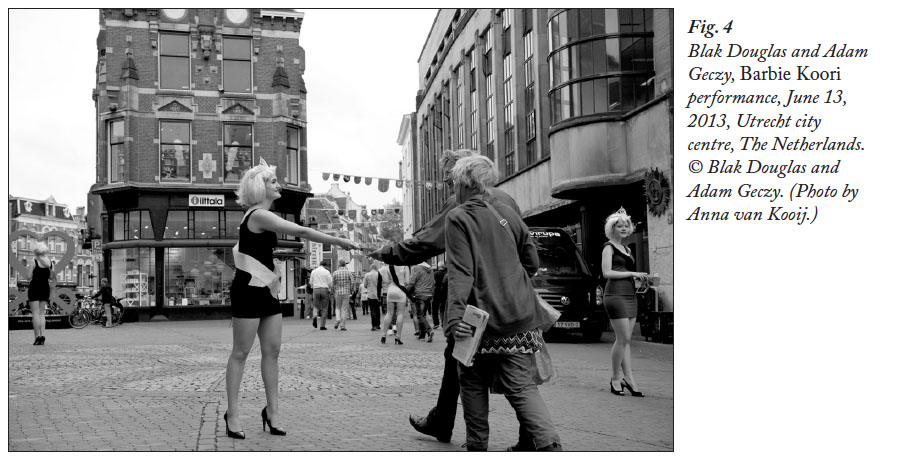 Display large image of Figure 4
Display large image of Figure 415 Performances to accompany the installation were possible since the AAMU remained open during the ten days prior to the opening on June 20. Providing a well-choreographed glimpse of the artists at work is part of a broader trend in display practice, whereby aspects of renovation, conservation and lab work are incorporated into what is on offer to the public (Bouquet 2012: 140-48). This gives display a temporal, living dimension: artworks develop and may even change in the process of their creation. This real-time view of artistic collaboration was preceded by some eighteen months of initial contacts, intermittent discussion between the curator and the artists. The invisible production process involved site visits, heavy email traffic concerning concepts and instructions between Utrecht and Sydney, and increasing staff involvement in Utrecht. The acquisition of the BMW, the production of the wax mouthpieces (for Lip Service), painting and installation of golf balls for the CLUB piece, printing of photographic works and more were all undertaken by AAMU staff.
16 If the term “delegated performance” (Bishop 2012: 94) is applicable to the range of activities undertaken by staff members, and indeed the actresses, then it raises vital questions about agency as well as context in the process of cultural production. One of the artists remarked that the car “took on a life of its own” as they were working on it in situ. The artist’s attribution of agency to the artwork in the process of its realization is connected with authorship and authority: who is entitled to use the Central Desert dotting technique? Which of the two artists—Blak Douglas who is of Koori/ Scottish or Adam Geczy of Hungarian descent—has the right to dot the Union Jack? By selecting and remixing symbolic repertoires, the artists question the cultural production of Aboriginal art and the struggles about its appropriation. In their collaboration it is not clear where the work of one artist begins or ends. The two artists, who define themselves as a black man and a white man, have been collaborating for ten years and, for this particular exhibition, for eighteen months. The exhibition poster, consisting of the words “black man white man” repeated over and over again, is based on the screen print in the exhibition and expresses the central dynamic of the show.
Black man white man: pedagogy
17 While Bomb is in one sense a parody, it also deliberately raises questions about tangible and intangible heritage, and intellectual property rights, in a fresh way. Many works use language/words as material shapes and forms, as well as in the usual way, as semiotic signs. The act of writing, or of using words in particular styles, can also be performative. The exhibition poster also connects with the piece chalked on the great wall upstairs, which had been prepared with blackboard paint, by Adam Geczy in a four-hour performance during which he wrote the words “white man,” ending with the words “dead man.” An act of atonement, or of reiteration, this ambiguous work is enacted in the very place that Dorothy Napangardi Robinson’s Kana- Kurlangu Jukurrpa, or Digging Stick Dreaming (2001; a black and white minimalist acrylic painting), hung in the museum’s previous exhibition. The current exhibition’s text points to White Man’s abstraction and suggests an analogy with Central Desert acrylic paintings, in which meaningful images may appear abstract to the uninitiated. And indeed, viewing the mural, with its abstract writing, through half-closed eyes transforms it into a minimalist work “constructed of a grid pattern of white dots on a black background,” as the curator described Napangardi’s painting (Petitjean 2010: 42). It is worth noting that Joseph Beuys, in his Directive Forces of a New Society at the Institute for Contemporary Art in 1974, also made use of one hundred chalkboards in his exhibition of a temporary university. The blackboard, as one of the archetypal instruments of schooling, provides this particular message with a powerful form: the act of writing is crucial to the formation of habitus and to the social reproduction of class domination. The punitive act of having to write lines was an instrument of 20th-century pedagogy.
 Display large image of Figure 5
Display large image of Figure 518 The insistent and repetitive sound of the Australian national anthem transforms words in yet another way. In the video work entitled Ausfailure National Tantrum, the Black Harmony choir of Redfern sings Blak Douglas’s rewritten version of the national anthem. The anthem is accompanied by a series of found images from the Internet depicting the race riots that took place on Cronulla Beach in Sydney in 2005. Adjacent to National Tantrum is Lip Service, a wall relief comprising ninety small and sixty large rings made of beeswax, which are mouthpieces for didgeridoos mounted on a brown wall, in the manner of a dot painting. Didgeridoos, which have become a national tourist object, originated from northeast Arnhemland and are called yidaki. Such mouthpieces are manufactured purely for the comfort of their new owners who purchase didgeridoos on the international tourist market.
19 Paying lip service to the flagrant injustices of Australian society will not do. Installed in two cases across from Lip Service is Silver Bullet—seven bullets in brown velvet–lined, wooden cases, each engraved with the name of a well-known Australian who, in the artists’ view, has violated human rights in their conduct. The act of writing names on the bullets is supposed to express powerlessness in the face of injustice: the expression “I don’t have a silver bullet for this” means there is no easy solution for a situation. These heavy 5-calibre bullets (used for shooting down helicopters) are not intended to kill the persons named, but rather “to eradicate evil or bad thoughts” (the AAMU label hastily interjects). These personalized bullets constitute a “still performance”—a symbolic shooting down of the seven persons for whom they are intended.
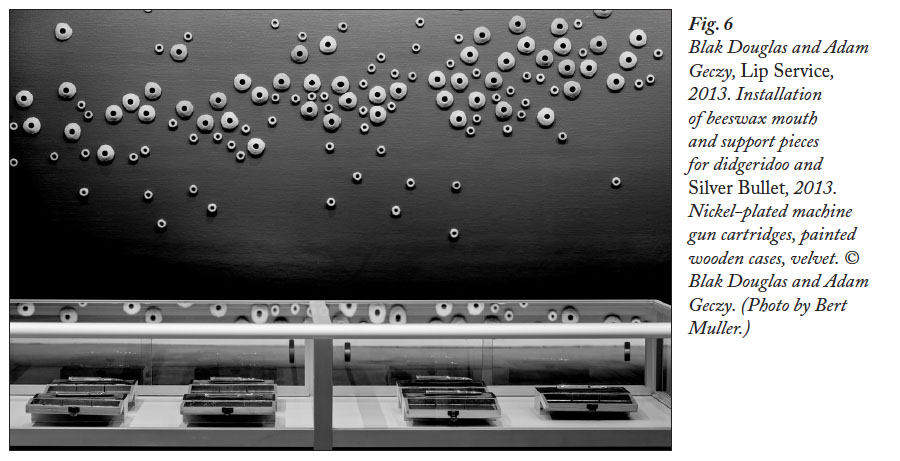 Display large image of Figure 6
Display large image of Figure 6Silver Bullet: Five Stories/ Nine Shots/Nine Ricochets/ Seven Bullets
20 Beyond its explicit content, Silver Bullet elaborates on earlier artistic controversies. Michael Nelson Tjakamarra’s 1984 painting The Five Stories was appropriated by Imants Tillers in his work The Nine Shots (1985), without the permission of the former, an act for which Tillers was criticized. According to McLean (2011: 41), mutual appropriation among artists is evidence of the contemporaneity of Western Desert painting. Howard Morphy remarks on the complex issue of artists such as Imants Tillers and Tim Johnson using Aboriginal motifs, when Aboriginal borrowings from Aboriginal and European art are taken into consideration: “What is the difference in principle between Gordon Bennett borrowing from Van Gogh and Imants Tillers borrowing from a work of Aboriginal art?” (Morphy 1998: 416). Artistic freedom is in each case circumscribed by varying rights to enter wider art discourses. While freedom to draw upon other people’s designs and incorporate them into one’s own work is essential, there is still a need to protect artists’ rights through copyrighting where historical inequalities are involved. Furthermore, some ethnically defined work, including “Aboriginal art,” clearly belongs in the category of contemporary fine art. By the same token, including some contemporary art in the category of Aboriginal art and excluding other works is problematic. As Morphy has put it,
21 It is exactly this ambivalence that Blak Douglas and Adam Geczy explore in their artistic collaboration for this exhibition. In Silver Bullet they clearly point to something more fundamental than who provided inspiration for whom in the exchanges concerning Imants Tillers’s Nine Shots and Gordon Bennett’s Nine Ricochets. Silver Bullet singularizes the word in the work’s title, while pluralizing the exhibited objects; it shifts from the interchanges among artists using painted representations of shootings to literal bullets with perpetrators’ names on them. The centrepiece is a box with the bullet for Australian police officer Chris Hurley who was present in 2004 when an Aboriginal man, Mulrunji, died in custody on Palm Island (Hooper 2006). If the artists’ point is about choosing your fights then it is powerfully made.
22 The photograph of a naked Aboriginal woman, lying on a rocky beach with her legs curled suggestively around a bollard painted with the Australian flag, takes up the historical narrative central to this exhibition: the rape of Australia initiated by the arrival of Captain Cook in 1770. The photograph is set on Kurnell peninsula where Cook landed, providing historical anchorage for the Barbie Koori piece earlier in the exhibition. The Profligacy shares the same narrow space as the video work 3 September, referring to National Flag Day in Australia, which captures hands scratching off a shoulder tattoo of the Australian flag. Both works manifest a deep aversion to the indifference shown by Australian nationalists for Aboriginal sensitivities in blatant colonial celebrations.
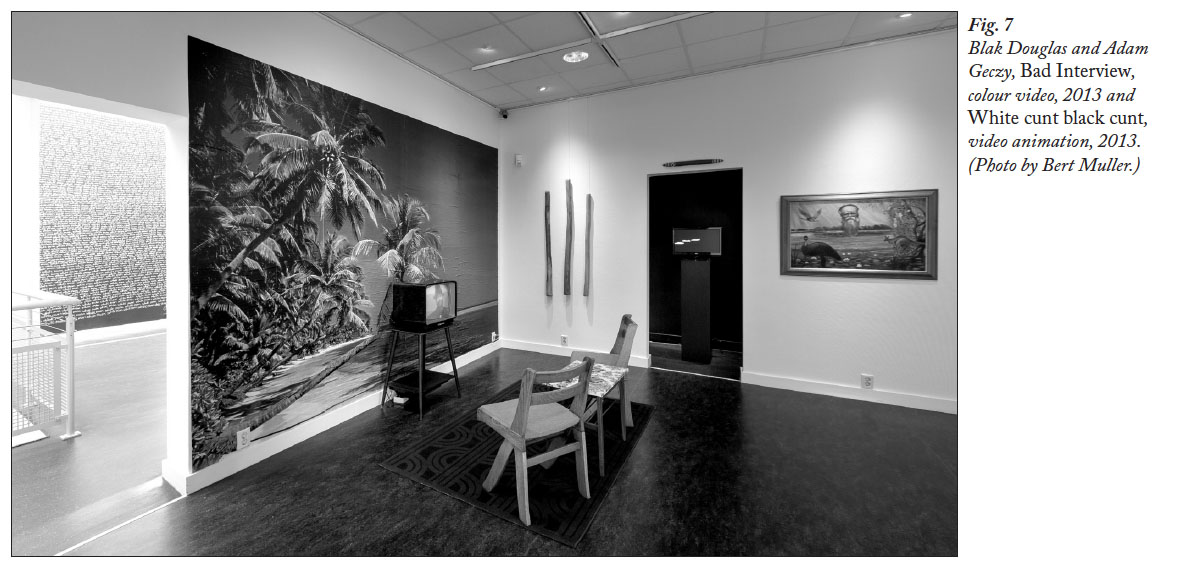 Display large image of Figure 7
Display large image of Figure 723 Throughout the exhibition the artists present and represent different forms of resistance to dominant Australian practices and national symbols: in scratching off a shoulder tattoo of the national flag, symbolically setting fire to the flag, inscribing names on silver bullets, and rejecting suitcases full of Australian flip-flop sandals embellished with the flag. The actress, Kate Bennett (who is also the model in The Profligacy), tries on countless examples but flings them all to the ground in the video work Refuse/ Refuse: none fit. The piece is edited so that the act of trying on and rejecting acquires a beat-box rhythm. The sound of this rap bleeds into the with the distorted voice of a television interviewer quizzing Blak Douglas about his views on the national anthem. This soundscape echoes the way murals here present three superimpositions upon territory. The first is a black, painted map entitled New Holland, with Dutch place names in white, dating from Dutch explorations of the continent in the 17th century. The second is the symbolic burning of the Australian flag imposed upon the territory by British colonialism. Thirdly, the stencilled graffiti-style Southern Cross in natural ochre colours reclaims the constellation that was appropriated for the national flag.
24 Then there is CLUB: coloured golf balls spelling out the four letters on a carpet of artificial grass. Golf courses occupy Aboriginal land dispossessed through colonization and used by one of the most exclusive groups of people. The pedagogical tone of the exhibition text is similar to that used in Silver Bullet: Aboriginal claims to sovereignty and resistance, symbolized by the colours of the golf balls—those of the Aboriginal flag—are weakened by internal divisions. The polyvalent word play in the title of CLUB, which evokes Aboriginal clubs as well as golf clubs, flawlessly conjures up a key site of contestation in this concatenation. If the seedy artificial grass repels the eye where an engraved silver bullet enchants it, that hideous green is not easily forgotten.
25 Downstairs, in the café at the back of the building, the video work Remarks on Racism consists of a reading from the Dutch captain Jan Carstensz’s logbook concerning his landing in northeastern Australia in 1623, where he describes his encounters with Aboriginal peoples. Carstensz regarded Aboriginal individuals as among the most “wretched creatures” he had ever seen—unacquainted with spices and metals and of no interest as trading partners, Aboriginal Australians were thus far removed from his Dutch vision of humanity. The old Dutch text is read by Adam Geczy’s young son Marcel, who does not understand what he is reading, and thus recalls American artist Gary Hill’s 1994 video work Remarks on Colour, in which the artist’s daughter reads from Wittgenstein. Although incomprehensible to Marcel, these ancient oddly articulated words can be recognized by Dutch speakers and send a shiver down their spine with the realization that Dutch explorers shared the prejudices of the later British colonizers.
Concluding Remarks
26 In using a national repertoire of flags, maps, anthems, talk shows, T-shirts, golf courses and tourist art as a set of artistic materials, the artists recuperate the ideologically obsolete and defunct, re-shaping them into aesthetically powerful forms that generate questions. This studied exploration of the operation of banality and hegemony employs various strategies: reiteration, surreal juxtapositions, bleedings of sound, performances, and an endless play on words and things. The artists use their own artistic collaboration, as black man and white man, to question the very premises of the Australian art world. These regenerative strategies not only parallel heritage dynamics but are part of them.
27 For Bomb is more than these two artists’ show—however powerful the show is. That power resides in the collaboration between this European institution, its staff and the artists. But is this a matter of the artists “colonizing” the museum? If colonialism is part of this artistic practice then it comes closer to the “colonial symbiosis” of “two dissimilar entities living together in intimate interaction” (Roque 2010: 34). There is mutual benefit to be derived from this critical show for both parties: for the artists, the museum provides an international platform for their work; and for the museum, activist art is one of the currents of contemporary art to present, as any other. A more fitting term for this configuration, which recalls Bourriaud while pointing to an area on which he is silent, is relational or critical museology (see Shelton 2013). Relational museology differs from relational aesthetics in researching the network of relations in which museums, collections and exhibitions are enmeshed. The commemorative celebrations for the Treaty of Utrecht framed this artistic investigation of Australian nationalism and cultural identity. The AAMU thereby articulates its position as a museum of contemporary Aboriginal Art as defined against, for example, the Centraal Museum (Fine Art) or the Catharijneconvent (religious art) within the network of Utrecht museums participating in the celebrations. The AAMU is the only museum in Utrecht with a collection of non-European art. The exhibition’s siting in the context of Utrecht thus adds new dimensions, which include the AAMU and its staff as active agents in an interactive process of cultural production.
28 The decision to invite the student beauty contest performers back to unveil Bomb (the centrepiece work) at the exhibition’s opening exemplifies the local dynamics of the show’s production. Bomb stood wrapped until the magical moment when the brown paper came off and the car emerged in its freshly painted glory. The guests applauded indulgently, affectionately. Unfortunately, the Bomb opening coincided with that of another Treaty of Utrecht contemporary art exhibition, Call of the Mall.2 Public circulation between these two openings was not optimal that evening, reflecting the way the program organizers saw these two events as quite separate.
29 When the show ended in January 2014, Bomb was accessioned to the AAMU collection and displayed on the outdoor terrace at the back of the museum. This move inaugurated a new phase in the work’s life history. How will the acrylic paint fare beneath a layer of varnish in the winds and weathers of Utrecht? Which conservational measures will be considered appropriate to preserve the work? Or will Bomb’s trajectory take a new and unexpected turn in the unfolding global art world? This new set of questions cuts to the heart of contemporary art, heritage and museology and their interconnecting relations.
